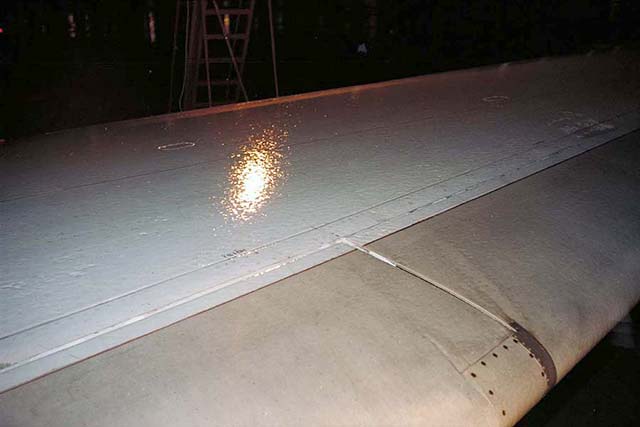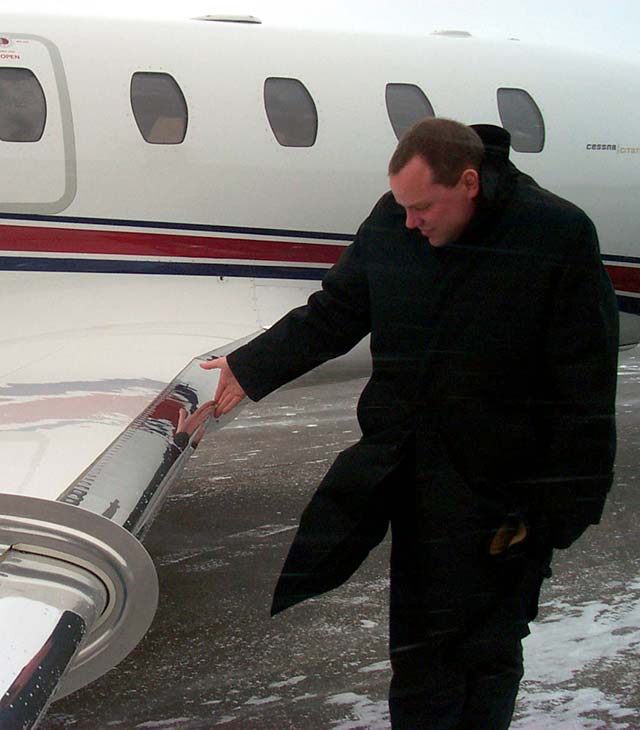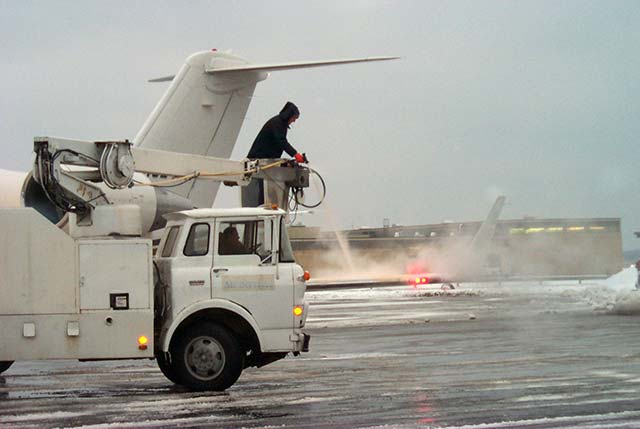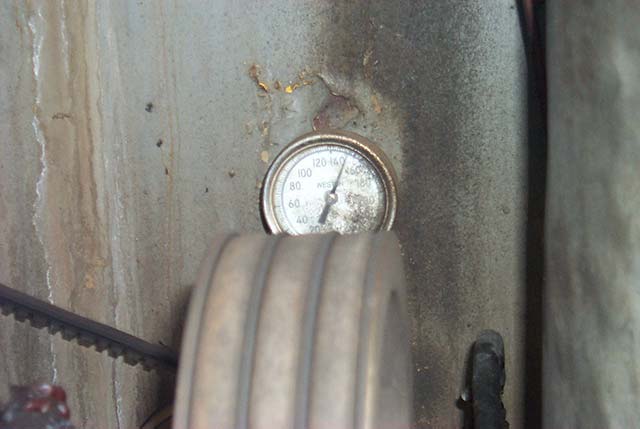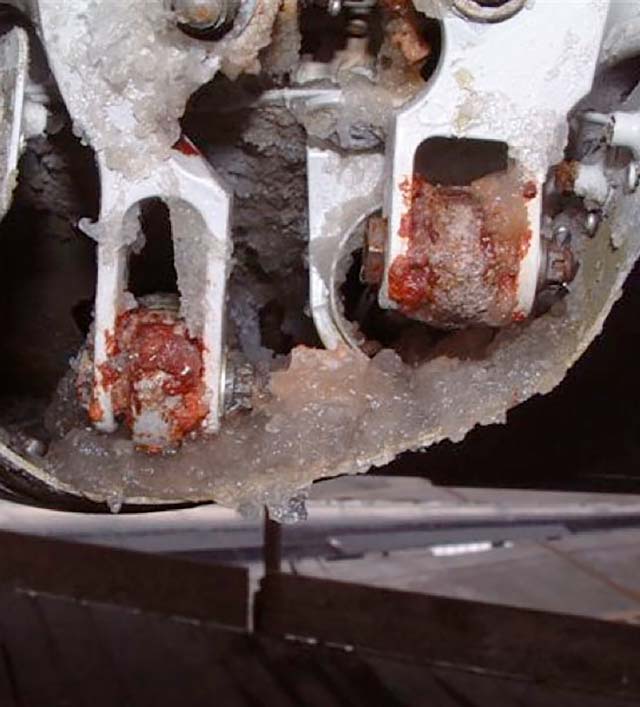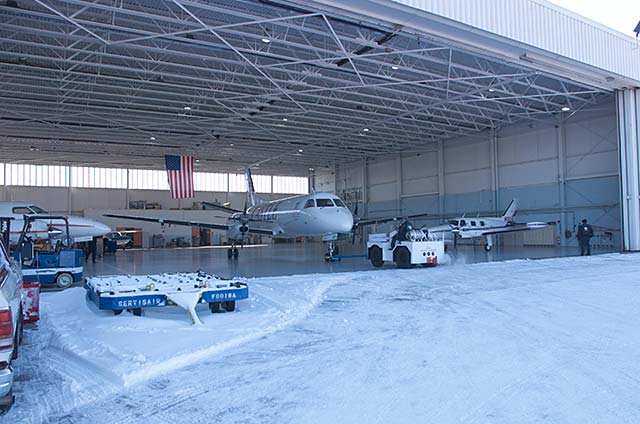A Pilot's Guide to Ground Icing
Module III - Fluid Basics
What you need to know
Section: Cautions
Start This SectionCautions Fluid Basics
Fluid Failure
Freezing precipitation and active frost continually add moisture to the fluid, thereby reducing the fluid strength. At some point, the fluid will "fail" – that is, it will no longer be able to absorb and melt the moisture.
To help yourself identify failure, take a good look at your wing/representative surface when the fluid is first applied. Usually, failed fluids are readily recognized when they transition from a glossy to a dull, opaque appearance. However, in freezing rain or freezing drizzle, there is only a subtle change in appearance. In these conditions, the surface will still appear glossy following fluid failure. A tactile check is usually required to tell the difference.
Cautions Fluid Basics
Fluid Failure
Looking at the wing from the flight deck to check for fluid failure is difficult in many aircraft types, particularly in high or swept wing configurations where the flight deck windows are far from the wing. Dusk/night or heavy precipitation can interfere with your ability determine the condition of the fluid. Regardless, you must be able to recognize fluid failure on the wing or representative surface.
Further Information
Active Precipitation and Fluid Dilution
De/Anti-icing fluids are highly soluble in water. As the fluid mixes with falling precipitation, it becomes more dilute. The resulting mixture of fluid and water at unknown concentration may run off the aircraft or begin to crystallize (freeze). If the applied fluid is unable to melt or absorb the frozen contaminants, it has failed. The aircraft will need to be deiced again.
Fluids Behind the Propeller
In turboprop or piston airplanes, anti-icing fluid may be less effective immediately behind the propellers. In the case of single engine aircraft, the prop wash distorts the accumulation of frozen precipitation on the cowling and windscreen. For these reasons, you should use another aircraft surface as a representative surface for your pre-takeoff and pre-takeoff contamination checks.
Fluid failure demonstrated under test conditions
Cautions Fluid Basics
Cold Temperature Concerns
Using fluids in very cold conditions – around -20C or below – raises some issues.
Aerodynamic Acceptance: In general, the colder the fluid, the more viscous it becomes. At some point, the fluid will become too viscous to adequately shear or flow off the aircraft. This creates an unacceptable aerodynamic situation.
Freezing Point: If the freezing point of the fluid is within the freezing point buffer (10C above the OAT for Type I or 7C above the OAT for Type II, III or IV), the fluid cannot be used.
These factors are both considered in the concept known as the Lowest Operational Use Temperature or LOUT. The LOUT is the coldest air or aircraft skin temperature at which a de/anti-icing fluid can be used.
Further Information
The LOUT for a given fluid is the higher/warmer of:
The lowest temperature at which the fluid meets the aerodynamic acceptance test for a given aircraft type based on rotation speed, or
The actual freezing point of the fluid plus a freezing point safety buffer: 10°C, for a Type I fluid, and 7°C for a Type II, III or IV fluid.
Consider the following situation:
· A Type I fluid has met the aerodynamics acceptance test down to –24C.
· The reported freezing point of the fluid is –36C (as measured by a Deicing Operator).
· The OAT is –29C.
Question:
Can this fluid be used to deice the aircraft under these conditions?
Answer:
The LOUT for a given fluid is the higher/warmer of:
· The lowest temperature at which the fluid meets the aerodynamic acceptance test for a given aircraft type, in this case –24C; or
· The actual freezing point of the fluid plus a freezing point buffer of 10C, in this case –36C + 10C = –26C.
The LOUT is –24C and the OAT is –29C. Since the LOUT is higher/ warmer than the OAT, this fluid can’t be used.
The safety buffer allows for errors in determining the actual glycol concentration prior to application, fluid dilution due to frost or precipitation, and/or aircraft skin temperature colder than the outside air temperature.
· For Type I fluids, the buffer is 10C above OAT.
· For Type II, III or IV fluids, the buffer is 7C above OAT.
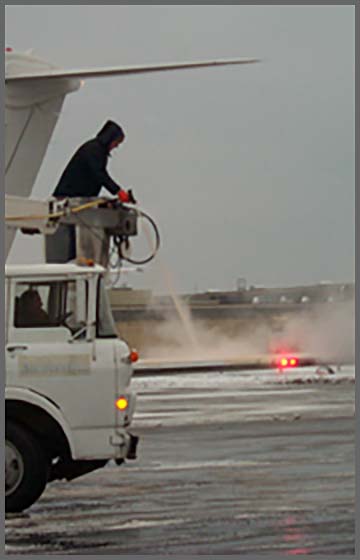
Related Information
"The Twin Otter aircraft was parked overnight on 21 March in Resolute Bay, NU. Overnight the weather was clear skies, light winds and the temperature was –38C. The following morning the aircraft was coated in a moderate layer of hoar frost with a temperature of approximately –36C. A deicer fluid applicator with a heater attachment was placed inside a heated building and allowed to warm-up for 1 hour. The applicator was carried outside, the fluid temperature was not measured but was hot to the touch and steam could be witnessed rising from the open fluid bottle. Fluid was immediately applied to the outer tip of the LH wing. Approximately three-quarters of a liter of fluid was applied to a 3 foot by 3 foot area of the wing. Fluid had a limited effect in melting the frost and seemed to combine with the frost in a gelatinous slush."
"The resulting slush had the consistency of Vaseline and was clearly not in a state in which it would flow off the aircraft during a take-off roll. In fact, the resulting slush had to be wiped from the wing (with some difficulty) with absorbent material."
Reference: “Twin Otter Type I Fluid LOUT Issue, Resolute”, Flight Comment Magazine, Ken Walper, DTA 5-6C2, 2005-10-17.
Cautions Fluid Basics
Storage and Handling
Whether you rely on a ground handling agent (FBO), or store and handle de/anti-icing fluids yourself, improper storage and handling can degrade the fluid quality.
Improper handling of fluids can degrade their quality. Some problems include reduced viscosity, which could cause the fluid to flow off the aircraft too soon, and reduced holdover times.
Query the ground handling agent (FBO) to gain confidence in their storage, transportation, heating, pumping and application procedures. If you control the fluids you use, be sure you adhere to the associated rules and regulations.
Further Information

Storage, labeling, handling and application of de/anti-icing fluids
The Canada Labour Code (CLC), Part II, The Aviation Occupational Safety and Health (A-OS&H) Regulations, Part V, and the Trans-portation of Dangerous Goods Act identifies the prescribed standards that must be ad-hered to with respect to Hazardous Substances, which includes the de-icing/anti-icing fluids used in conjunction with ground icing operations and ensures the health and safety of all employees. It is both the operator's and pilot's responsibility to make sure this fluid is properly and safely stored, labeled, handled and applied correctly.
Cautions Fluid Basics
Fluid Dryout & Re-hydration (Jelling)

The content below is primarily for pilots of larger aircraft - turboprops, corporate jets and larger.
Some pilots have reported incidents of restricted flight control movement during flight. These have been attributed to Type II or IV fluid dryout and re-hydration. In these cases, repeated application of Type II or IV fluid as an anti-ice treatment or when applied at night to protect against morning frost caused residues to collect and accumulate in aerodynamically quiet areas such as control surface gaps or cavities.
With time, the glycol antifreeze component of the Type II or IV fluid evaporates, leaving a dry, grey or blackish residue, comprised largely of the thickening agent, which is very hygroscopic and has little or no antifreeze properties.
Related Information
MULTIPLE INCIDENTS
2004-2005
BAE-146, EMB-145, & DHC-8
During the winter of 2004/2005, UK-based airline operators experienced numerous incidents of restricted elevator and aileron controls on their Avro 146-RJ100 fleets. One operator also reported occurrences of restricted elevator controls on its Embraer 145 and Bombardier DHC-8 aircraft. These aircraft types are similar in having non-powered flight controls. Other European operators of Avro 146/RJ-series aircraft also reported flight control restriction events during the same period. Many of these events were found to be associated with residues of ‘thickened’ de-icing fluids, that had accumulated in the aerodynamically ‘quiet’ areas of the elevator and aileron controls. These residues rehydrate on exposure to precipitation and can freeze at altitude, with the potential for restricting control movement. In most of these incidents, the control forces returned to normal after the aircraft had descended into warmer conditions. Despite recent industry efforts at addressing the problems posed by such residues, an effective solution remains to be found. This bulletin reiterates the safety recommendations issued in a recent AAIB bulletin, which stated that the build-up of such residues must be avoided through a tightly controlled regime of inspection and cleaning, and that new types of thickened fluids must be developed, whose residues do not cause flight control restrictions on aircraft with non-powered flight controls.
ENROUTE, UK
MARCH 30, 2005
BAE-146
Passing FL270 in descent with speed 280kts and the autopilot engaged, the aircraft executed an uncommanded left turn. The autopilot was disconnected and the ailerons were found to be frozen (roll spoilers appeared to operate normally on the gauges) and the aircraft was difficult to control in roll. Further descent was initiated promptly and control recovery was observed to start at FL130, although full recovery was not complete until passing 3000ft (OAT 0deg C). The reporter suspects the recurrent problem of refreezing of de-icing fluid, although the aircraft had not been de-iced for at least the previous 2 weeks.
Findings: Minor contamination of the aileron servo actuator found. Extensive cleaning carried out and aircraft released to service.
On the next flight later that same day: aileron controls were very stiff. PAN declared and the aircraft diverted. Controls freed up as the aircraft descended through the freezing level.
Additional Findings: Further contamination was noted under the final drive panels on the left hand and right hand ailerons and on the left and right elevators. Contamination was removed and areas thoroughly cleaned. Aircraft returned to service.
Cautions Fluid Basics
Fluid Dryout & Re-hydration (Jelling)

The content below is primarily for pilots of larger aircraft - turboprops, corporate jets and larger.
The repeated application of thickened fluid causes the residues to accumulate in increasing quantities, unless removed by regular cleaning. On exposure to moisture, for example, during rain showers, the residues will absorb water and swell to many times their original volume, to form a thick gel (similar to wallpaper paste) which can bridge the gaps between flight control surfaces and adhere to control mechanisms.
Typically, cleaning can be done by activating the dried residue using water and then by washing with hot Type I or hot water, as appropriate for the prevailing temperature. Check with the aircraft manufacturer for guidance.
Related Information
ENROUTE, UK
APRIL 4, 2004
EMB-145
In cruise the aircraft began to oscillate in pitch until the autopilot disconnected. The aircraft was found to be nose heavy in trim - aircraft retrimmed and autopilot reengaged. Further occurrences of oscillations required manual trimming with the autopilot dis-connected. The aircraft was hand flown in descent with evidence of restricted elevator movement. On descending through 0 deg C isotherm, normal control returned and a normal landing carried out. Subsequent engineering inspection revealed a gel type fluid in the trim tab hinges. The reporter comments that according to the Tech Log the aircraft was last de-iced on 24 Mar 2004 using Type II+ 50/50 mix fluid and prior to that on 17 Mar 2004 using Type II+ 100% mix fluid.
Findings: Minor contamination of the aileron servo actuator found. Extensive cleaning carried out and aircraft released to service. On the next flight later that same day: aileron controls were very stiff. PAN declared and the aircraft diverted. Controls freed up as the aircraft descended through the freezing level.
Additional Findings: Further contamination was noted under the final drive panels on the left hand and right hand ailerons and on the left and right elevators. Contamination was removed and areas thoroughly cleaned. Aircraft returned to service.
Cautions Fluid Basics
Anti-Icing Application in a Hangar
Some operators choose to anti-ice their aircraft in a hangar. The advantage is that the fluid is protected from the precipitation during application. As long as the aircraft is removed from the hangar without delay, this would seem to be an acceptable practice.
However, the longer an aircraft remains in the hangar, the greater the potential for unacceptable fluid performance. Two factors to consider are:
(1) the fluid runs off the aircraft surfaces, and leaves an unknown and perhaps unacceptable fluid thickness;
(2) too much water evaporates from the fluid so that it does not shear/blow off the aircraft surfaces during the take-off roll.
These effects are accelerated if the hangar is heated.
Related Information
Fluid Failure after Extended Hangar Stay
In anticipation of light snow, a Type IV fluid was applied to a business jet in a heated hangar several hours prior to its scheduled departure.
When the aircraft was towed out of the hangar, no precipitation had fallen as earlier predicted and the OAT was -17C. The LOUT of the fluid used was -24C.
During cruise flight, one of the flight crew conducted a visual inspection of the wings and discovered that the Type IV had not completely migrated off the wings during take-off. Frozen Type IV residue covered most of the wing trailing edge surface, from tip to root.
It is speculated that water evaporated from the anti-icing fluid during the time the aircraft was in the heated hangar, and therefore caused it to fail on take-off.

Cautions Fluid Basics
Anti-Icing Application in a Hangar
If you practice this option, consult with the fluid manufacturer for guidance, or begin the HOT clock as you would applying the fluid in the elements.
Bottom line: check the condition of the fluid prior to pulling from the hangar if there has been a delay since application. And, as always, check the condition of your wings or other critical surfaces immediately prior to take-off.


